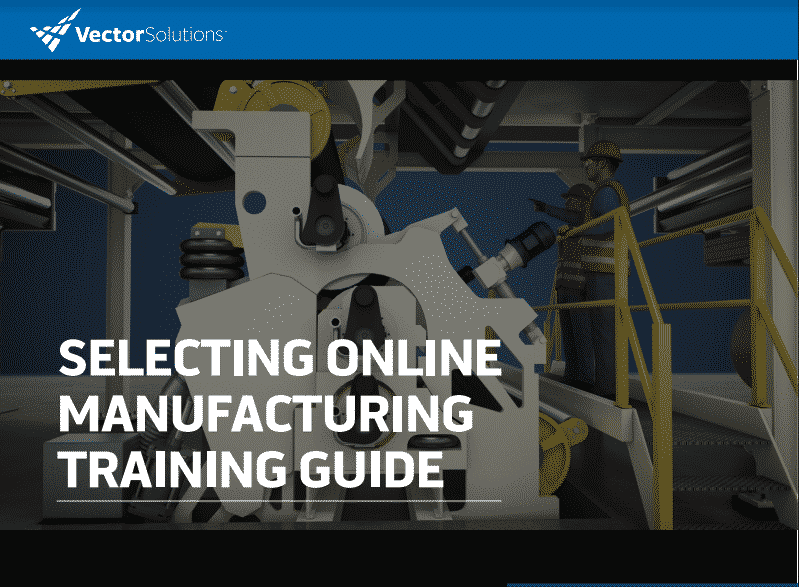August 27, 2021

Online Manufacturing Training: Tips for Selection & Use
Industry:
Solution:

Many manufacturing and industrial companies make a significant investment in training their employees. And that investment pays off in many ways, including:
- Quicker, more efficient new employee onboarding
- Better retention of new hires and employees in general
- More efficient skill development amongst employees, including developing skills for their current job as well as reskilling and upskilling
- More easily satisfying compliance training requirements
- Improved employee morale and engagement
- And lots more
As part of that training effort and investment, many manufacturers have already made the move to add online training as well. That was true before the COVID pandemic--many companies were already using online training. And the arrival of COVID only increased the use of online training in manufacturing sites. Employers saw online training as a safe, healthy alternative to face-to-face instruction during the deadly pandemic.
And there's no reason to think we'll "go back" to less use of online training when the pandemic finally ends. Companies have made investments in things like elearning courses, learning management systems (LMS), and platforms for virtual instructor-led training (VILT). Learning and development professionals have acquired new knowledge and developed new skills, mastering e-learning authoring tools, learning management systems, and techniques for developing and leading virtual instructor-led training. Employees have become familiar with and learned to use online training and have experienced some of the benefits.
But not all manufacturers are fully there with online training. Some haven't made the move to online at all. Some are using online but not as much as they could. And some are using online but aren't using it as well as they could to help share knowledge, develop skills, and stay compliant.
In this article, we're going to give industrial and manufacturing companies some tips about selecting and using online training. These tips are from our Guide to Selecting and Using Online Manufacturing Training, which you can download from this article.
The tips in this article will help your organization find the right online training solutions for your training needs. This includes training providers, manufacturing training courses, and learning management systems. The tips will also help you make better use of online training for employee development, including giving tips on creating effective blended learning solutions.
Read on and let us know if you have any questions.
[optin-monster slug="ols6gbrjaaaeu127bvxk"]
What Is Online Manufacturing Training?
Let's start by defining our terms. What are we talking about when we talk about online training?
At one level, the answer is simple. Online training is training that takes place online. Although with the arrival of virtual reality and augmented reality, even that answer isn't quite as obvious as it used to be.
But in general, when people talk about online training, they're talking about a small number of things: learning management systems, elearning courses, live virtual instructor-led training, and other training activities that can be delivered online.
Let's introduce the learning management system first. This is often shortened to simply LMS. A learning management system is a software application used to assign, deliver, and track job training. You can get an LMS installed on your company's own network server, but these days, it's more common to get a cloud-based LMS. And although an LMS is an internet-based software program and you CAN use it for tracking online training, you can use it to assign and track training that occurs offline (classes, OJT, etc.), too.To learn more about learning management systems, read the following articles:
The next thing to talk about are elearning courses. eLearning courses are online training activities that learners complete in an asynchronous manner. If you don't know that word, it means the learner completes an elearning course all alone, in a self-guided manner.
eLearning courses can differ from course-to-course and producer-to-producer. However, many have a similar structure that includes an introduction to the learning objectives, training content, practice exercises, and a test or assessment at the end.
In theory, you can have an elearning course on just about any topic. Different workplaces would be interested in different training materials on different topics, of course. A manufacturing or industrial company might be interested in elearning courses on topics like these:
- Principles of manufacturing
- General manufacturing operations
- Industry-specific manufacturing, including manufacturing processes and job roles
- Industrial maintenance
- Facilities maintenance
- Safety/EHS
- Lean
- Quality
- Continuous improvement
- Basic math and science
- Basic computer skills
- Critical thinking and problem solving
- Communication and teamwork
- HR compliance
- Diversity, equity & inclusion
- Professional development
- IT & Cybersecurity, including certifications/continuing education
- Project management, including certifications/continuing education
- Engineering, including continuing education
You can learn more about elearning courses for manufacturing employees here.
Next, let's talk about virtual instructor-led training, also known as VILT or live online learning. VILT is using something like a webinar platform to teach a class online. It can be a one-to-one training or an instructor with several students, although smaller class sizes are recommended for VILT.VILT is synchronous, meaning the students complete the training together and along with the instructor. This means an instructor can provide demonstrations of how to complete a job task, ask students to perform the task, and provide helpful feedback. The instructor can ask questions and answer questions from the workers, too.
It's important to know that there's more to being an effective VILT instructor than simply showing up in a webinar tool and talking or lecturing. Don't take the "sage on a stage" routine online. For more on this, check out our interview with L&D and VILT pro Shannon Tipton: Live Online Learning.
Between elearning courses and VILT, these will make up most of your online manufacturing courses. But there are more types of training activities that can occur online for a richer, more effective learning experience, and an LMS can help you assign, deliver, and track them. These include:
- Video files
- PowerPoint presentations
- .PDFs
- Links to HTML pages, including wikis, SharePoint, blog articles, knowledge management systems, etc.
- Links to online workplace communication tools, such as Slack channels
- Online SOPs/checklists (your LMS should help you make these)
- Online surveys (LMS should help with this)
- Online quizzes (LMS should help with this)
- Online bullet boards & discussion groups
Blended Learning Solutions
Now let's quit talking about the "what" of online industrial training and talk about the "how."
There are many learning myths out there to avoid and many evidence-based training practices to use. We can't get into all of them in this article, although the links we just offered are helpful.
But one of the best ways to help employees learn about manufacturing and learn to master their own manufacturing job roles is to use a blended learning solution. Put simply, this means to deliver training on a particular topic using more than one delivery method, such as instructor-led training, elearning, and virtual instructor-led training. You can even toss in some more online microlearning courses delivered to worker's phones after the initial training for what's known as spaced practice.
Feel free to download our Guide to Blended Learning Solutions for more on this.[optin-monster slug="riyybq22uhna90k9jtk5"]
You'll also want to conduct a proper front-end analysis so you make proper training decisions. A front-end analysis, also sometimes called a training analysis, a training needs analysis, or a training needs assessment is all about being your homework first before you jump right into training design and development. This article on human performance improvement, or HPI, includes more detail about conducting your front-end analysis (it explains the HPI model from the Association of Talent Development), but we'll explain a few things here.
First, if your training is intended to solve a problem of some sort, make sure you understand the problem. And figure out how solving the problem aligns with business goals. Next, investigate to discover the cause of the problem. It may turn out that training can solve that problem, but it may also turn out that training won't help. If it turns out training can help, now it's time to learn more about the employees who will be the learners of your manufacturing training. What do they know now? What are their schedules? What languages do they speak and read? What is their access to technology (if you want to use online training, for example)? And from there, you just continue through with a training development model like ADDIE or something else, writing your learning objectives and assessments, conducting your evaluations, and more.
You'll find even more helpful information about developing manufacturing training to help employees acquire knowledge, develop skills, and progress in their manufacturing careers in our Guide to Manufacturing Training that Works.
[optin-monster slug="ey7geadahf1btflqowgn"]
Making the Right Online Manufacturing Training Selections
When used properly, online manufacturing training can improve the learning outcomes at your worksite. You can onboard new workers more thoroughly and efficiently. You can help employees develop necessary skills for their first jobs and for their entire manufacturing career path. You can develop methods for employees to identify mentors and to share knowledge. You can standardize your training and improve production, quality, and safety at your site.
But not every LMS, or elearning course, or online manufacturing training provider will be a perfect fit for your organization. That doesn't necessarily mean they're bad, it may just mean they're a better fit for some other organization.
Our two biggest recommendations to you in your search for online manufacturing training are to (1) make sure you know what your want online training to do at your organization before you go out searching and buying and (2) create a diverse internal team (with upper management, rank-and-file employees, supervisors, IT, Operations, Quality, EHS, L&D, and more) to help define use cases before you begin your search.To help you even more with your selection process, please check out the following articles:
- What to Look for in Online Manufacturing Training Courses
- What to Look for in an LMS for Manufacturing Training
Additionally, you may want to listen in on our previously recorded, on-demand webinar, Selecting & Using Online Manufacturing Training as well as our on-demand webinar Beginner's Guide to Online Training.
And finally, check out our 6 Steps of Effective Manufacturing Training article, download our Manufacturing Training Guide, and download our Guide to Online Manufacturing Training, too.
[optin-monster slug="u9s1g6za00ifytnjay9v"]
Explore our software solutions designed to help your organization succeed
Request a Demo






